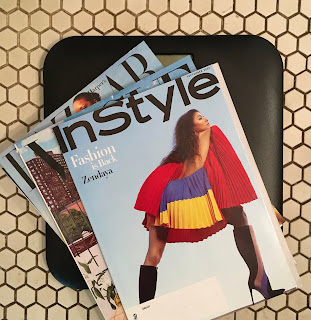Part of me wanted to forget about this little exercise, just as I'd like to forget about 2020. Every year the September issues lose heft. No surprise that this year's weigh-in went from 9 pounds in 2019 to 4.6 pounds this year. They are down...but not out, thank goodness.
My Fab Five are Vogue, the leader in page count at 316, followed by Elle at 232, Harper's Bazaar at 231, InStyle at 180, and Marie Claire (with something called a Fall Issue), at 172 pages. It doesn't take much to think Marie Claire's next issue will be Holiday.
Comparing this to last year would be an exercise in futility. Let's just be grateful we still have all five. Anna Wintour continues to top the masthead at Vogue. Rumors of her leaving the post never end—she's also artistic director of Condé Nast—but she remains, probably the most powerful name in American fashion.
There have been some new appointments to the Editor in Chief position. Glenda Bailey stepped down at Harper's Bazaar after 19 years. Other than being an "unexpected departure" and that she is still affiliated with Hearst as a global ambassador, no reasons were forthcoming. Samira Nasr, formerly Executive Fashion Director of Vanity Fair, has filled her position. Aya Kanai, formerly Chief Fashion Director for Hearst, has taken over the reins at Marie Claire. The EIC at Elle continues to be Nina Garcia, InStyle still has Laura Brown.
This matters little to most readers of fashion magazines, probably not at all to someone who picks up a September issue as a seasonal treat, but it matters a lot in terms of content and direction.
Each of this year's September issues features a woman of color on its cover. Vogue commissioned two artists, Kerry James Marshall and Jordan Casteel, for its two covers. Kerry James Marshall chose to portray an anonymous figure; Jordan Casteel painted the fashion designer Aurora James. Cardi B, Rihanna and Zendaya grace the others. I'm not exactly dazzled. Those last three have been around. Dare I say they are a bit shop worn?
Jordan Casteel's portrait of Aurora James is a hard-edged one. It's not pretty, which is saying something. I do like the Kerry James Marshall cover as it reminds me of the surreal fantasies of illustrated Vogue covers in the 1930s. Looking closely, that is, however, a very somber face. Unfortunately this may be the truest reflection of where we are in fashion now. Fantasy and reality in 2020 are oil-and-water ingredients.
This is what we've got. Now to see what we've got inside.








